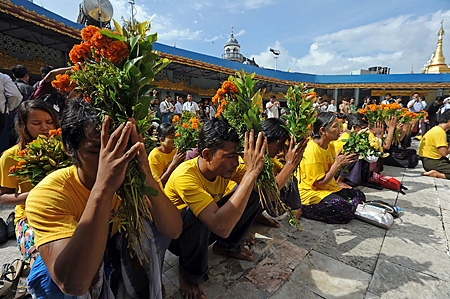
Protesters in Burma offer prayers at the Sule Pagoda after they agreed to call off a rally when asked by the authorities to do so, in downtown Rangoon on September 26, 2011. (Photo: AFP / Getty Images)
Four years ago, as columns of burgundy-robed monks marched peacefully through Burma’s commercial capital Rangoon, security forces opened fire, slaughtering at least 31 people, arresting thousands more and extinguishing hopes that the ruling junta was receptive to political reform. On September 26, dozens of Burmese again gathered at a Buddhist pagoda in Rangoon to mark the fourth anniversary of the crushed protest movement. This time, however, the heavy, tropical air did not crackle with gunfire. Mass arrests did not ensue. Although some protesters were stopped from participating in other parts of town, those gathered at the holy Sule pagoda staged a peaceful gathering before security personnel eventually dispersed them. Some demonstrators were wearing bright-yellow T-shirts demanding the release of Burma’s political prisoners. Others sported shirts that opposed the construction of a Chinese-built dam in the country’s northern Kachin state that critics contend will destroy the environment, even as most of the future electricity will be sent to China’s neighboring Yunnan province.
Does this rare rally prove that Burma is actually serious about change? Last year, the country, which is also known as Myanmar, held its first elections in two decades, after ignoring the results of the previous poll that Nobel Peace Prize laureate Aung San Suu Kyi’s National League for Democracy (NLD) won. The 2010 balloting was marred with irregularities, and the NLD did not take part. Still, Burma’s military regime trumpeted the fact that in March some degree of political authority was handed over to a civilian government led by a retired general, President Thein Sein.
Skeptics—and there are many—contend that nothing has really changed in Burma and there is no glasnost in sight. The so-called civilian government has an awful lot of ex-military members among its ranks, and real power is still reserved for top brass. The political prisoners whose plight was publicized on the protesters’ T-shirts still number around 2,000, and the jails to which they are confined are among the world’s worst. Cronies of the military have snapped up lucrative concessions, while millions live in dire poverty. In the country’s north, fighting has flared between Burmese forces and members of an ethnic militia, the Kachin Independence Army. Recent NGO reports have highlighted continuing oppression of women and children, as well as deplorable behavior by the Burmese military, particularly in ethnic areas. The elected parliament aspires to even rubber-stamp status.
(PHOTOS: The long, hard fight for democracy in Burma)
Nevertheless, there may be cause for small hope—and not just because of the landmark gathering in Rangoon yesterday. Suu Kyi was released from house arrest last year and has given political speeches without incident, even traveling outside Rangoon and meeting with senior government leaders. Her NLD also held a ceremony at its headquarters marking the fourth anniversary of the 2007 protests, which was attended by hundreds of people. Although journalists continue to be jailed, a modicum of censorship has been lifted from the cowed press and they are now allowed to cover some parliamentary sessions, unlike before. Foreign news websites that were once blocked have been accessible of late.
All in all, regular visitors to Burma describe a changed urban atmosphere, a commercial buzz now that more foreign investors have come knocking. Although the West maintains economic sanctions on Burma for its human-rights record, other countries, most notably its Asian neighbors, have poured money in to secure the nation’s rich natural resources. Such resource grabs can easily exacerbate rich-poor tensions in any country. But Burma is at least trying—for the first time, really, since the military grabbed power in 1962—to put together some semblance of financial planning. A respected economist has been brought in to advise the government, which in a previous incarnation was so inept that a former leader decided to denominate the currency by the number nine because it was his favorite digit.
Any change in Burma is, of course, painfully incremental. There have been previous false dawns of reform. But for a nation that regularly places toward the bottom of various country-by-country rankings of democracy, health, education, media and Internet freedoms, any positive sign is encouraging. That’s the best that can be said in Burma.

